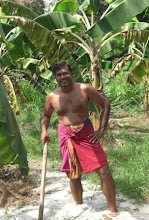You may have seen a photo below where a bunchof manoges hangs onto my verandah. Well it is from the large mango tree on the side of my cabin.
I brought over 800 mangoes from a few branches of that enormous tree to my shop last week and in the shop 400 that were put out for Saturday sales day were sold in minutes. Maybe my asking price of 15 rupees a mango was too low. I sold a further 200 to houses in Colombo on my Monday delivery too and even that was not enough to satisfy the demand. This was the first true bumper harvest I have received from anything in my life, and I am so grateful to the boys for going to a lot of trouble to protect the Mango from the threat of Bats, Rock Squirrel, other birds and most of all the two common varieties of monkey that are pests on my land.
The tree being so big, they have to climb very high risking life and limb, and then make sure the mango only falls into the basket and not to the ground where it will get smashed. Then once the mangos are plcked they have to be carefully washed and then each dried of the mango milk that iswaxy, so the fruit does not spoil. Once individually dried with a towel they are spread evenly on a mat so they do not touch each other to ensure that most are saved from spoilage.
My customers can attest to the fact that they are honey sweet unlike any mangoes elsewhere as they ripen on their own and are not aided in doing so as others sold in shops today.
My staff and I only end up eating half eaten mangoes that fall, as we want to save the best for the customers.
I next go to Hingurakgoda on Maonday night, 6th and I hope to get another like number cut from branches which would now be ready to be plucked from. My sister Nelun and my sister in law Sherene are coming there next week and they can pluck their mangoes as all the kids love sweet mangoes.
I have about 10 mango trees but only this tree which is by the river gave me a crop this season. The other trees are likely to give me a crop at christmas.
In the last few weeks I have planted three villard mango plants in Godagama and I have bought three more for planting in Hingurakgoda, namely two villard and one Karthakolomban.
Sadly even though I requested from my neighbors to sell me their mangoes, they have been tempted by cash where people come in lorries offer a sum for the tree, and cut all the mangoes before they are ripe and take them away for sale. They spray carbide to force ripening and that is what you see, ghastly yellow mangoes. My customers therefore being used to this carbide yellow ask me if mine are ripe as they are only turning a light yellow, but that is the true natural ripened tint now forgotten in the rush to cash in on quantity at the expense of quality.












































